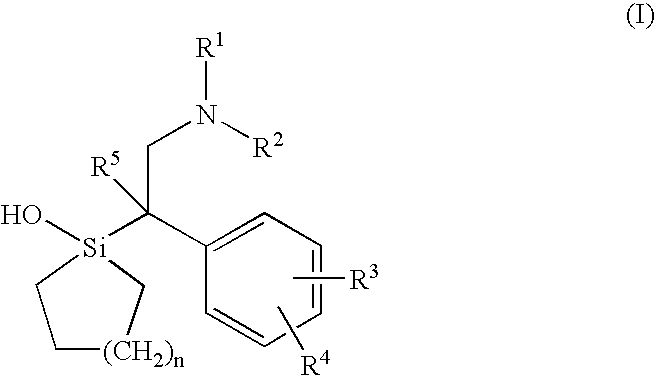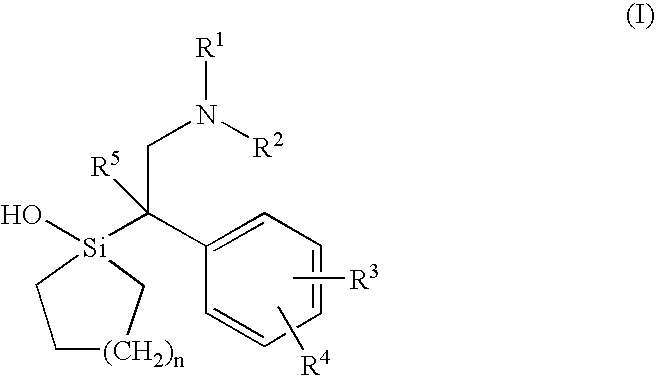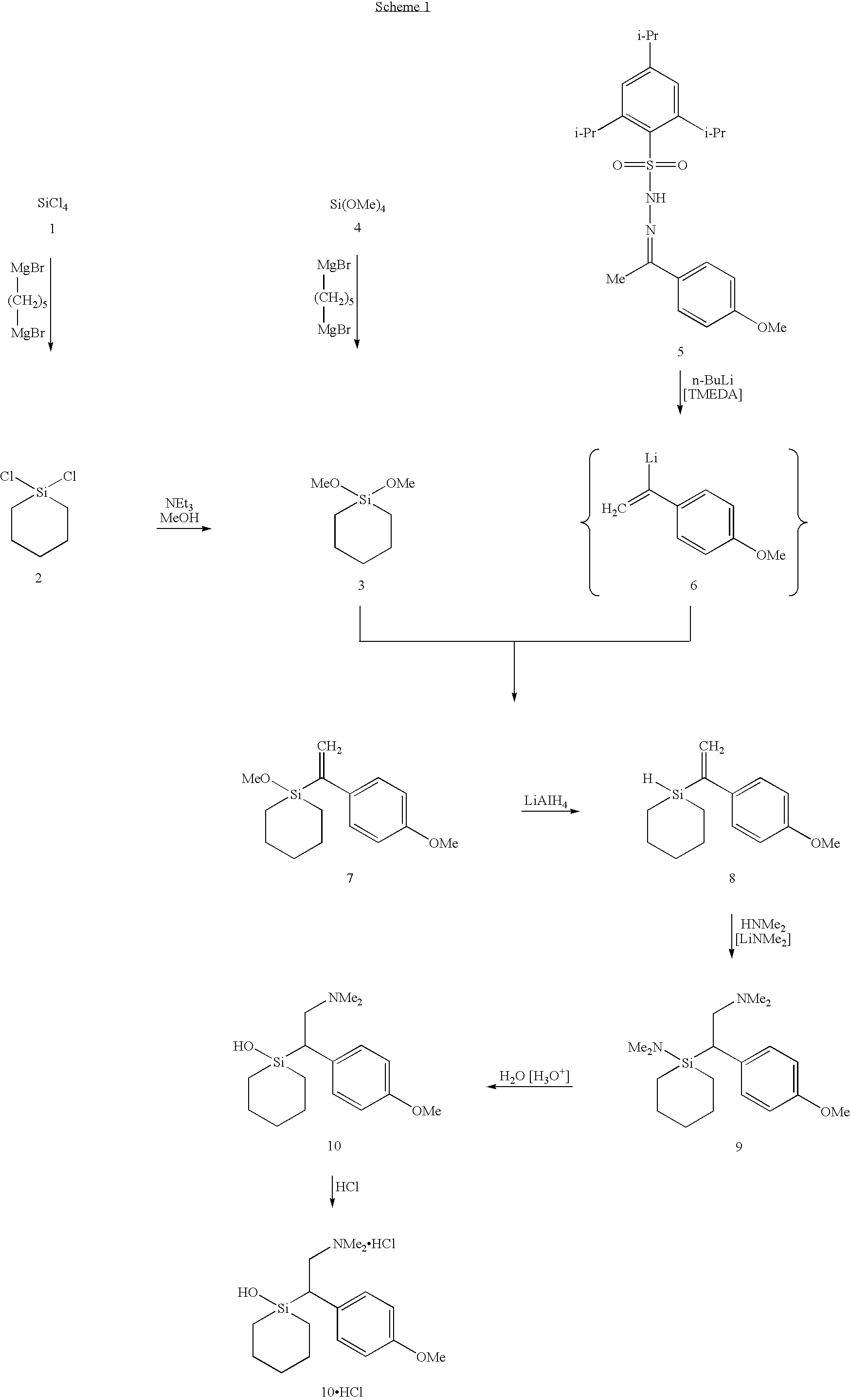Silicon compounds
a technology of compounds and compounds, applied in the field of compounds, can solve the problems of side effects, headache, nausea, insomnia, etc., and achieve the effects of improving pharmacokinetic profile, improving pharmacological profile, and improving patient toleran
- Summary
- Abstract
- Description
- Claims
- Application Information
AI Technical Summary
Benefits of technology
Problems solved by technology
Method used
Image
Examples
example 1
1-[2-Dimethylamino-1-(4-methoxyphenyl)ethyl]-1-silacyclohexan-1-01 (Sila-venlafaxine, 10; identical with (±)-10).
A 2.7 M solution of n-butyllithium in n-heptane (35 mL, 94.5 mmol of n-BuLi) was added dropwise at −50° C. within 10 min to a stirred solution of dimethylamine (21.6 g, 479 mmol) in tetrahydrofuran (100 mL). The resulting mixture was allowed to warm to −10° C. within 2 hours and was then cooled to −40° C., followed by dropwise addition of 8 (20.0 g, 86.1 mmol) within a period of 15 min (evolution of hydrogen; rise in temperature from −40° C. to −35° C.). The resulting stirred yellow solution was allowed to warm to −20° C. within 2 hours and then kept undisturbed at −26° C. for 16 hours. Subsequently, the solution was allowed to warm to 20° C., and the solvent was removed in vacuo in a water bath (5-15° C.) until a residual volume of 50 mL was obtained. This solution was diluted with diethyl ether (200 mL) and then added in one single portion at 0° C. to a stirred two-ph...
example 2
(−)-1-[2-Dimethylamino-1-(4-methoxyphenyl)ethyl]-1-silacyclohexan-1-ol ((−)-Sila-venlafaxine, (−)-10).
(a) Seed Crystals of (−)-Sila-venlafaxine(+)-10-Camphorsulphonic Acid ((−)-10·(+)-CSA).
A solution of (+)-10-camphorsulphonic acid ((+)-CSA) (792 mg, 3.41 mmol) in acetone (25 mL) was added at 0° C. to a solution of (±)-10 (1.00 g, 3.41 mmol) in acetone (25 mL). After the mixture was shaken briefly, it was kept undisturbed at 0° C. After ca. 10 min, thin needle-shaped crystals precipitated. A further 40 mL of acetone was added immediately, and the mixture was then kept undisturbed at 4° C. for 2 days. The precipitate was isolated by filtration, washed with acetone (20 mL), and recrystallised twice from boiling acetone (45 mL). (To leave a few seed crystals, the solid was not allowed to dissolve completely in both recrystallisation steps). The product was finally isolated by filtration, washed with acetone (3 mL), and dried in vacuo (0.001 mbar, 20° C., 6 hours) to give 629 mg of:...
example 3
(+)-1-[2-Dimethylamino-1-(4-methoxyphenyl)ethyl]-1-silacyclohexan-1-ol ((+)-Sila-venlafaxine, (+)-10).
The combined mother liquors obtained in the preparation of (−)-10·(+)-CSA (see above) were used to prepare (+)-10. For this purpose, the mother liquors were concentrated in vacuo, treated with potassium carbonate as described for the preparation of (−)-10, concentrated again, and the oily residue was then treated with (−)-CSA as described above. (a) (+)-10(−)-CSA. Yield 32% (related to (±)-10) of a colourless crystalline solid (3.29 g, 6.26 mmol); mp 164° C. (b) (+)-10. Prepared from (+)-10·(−)-CSA (3.23 g, 6.14 mmol); yield: 94% of a colourless crystalline solid (1.70 g, 5.79 mmol); mp 64-65° C.
PUM
| Property | Measurement | Unit |
|---|---|---|
| pharmaceutical composition | aaaaa | aaaaa |
| blood pressure | aaaaa | aaaaa |
| hydrolysable | aaaaa | aaaaa |
Abstract
Description
Claims
Application Information
 Login to View More
Login to View More - R&D
- Intellectual Property
- Life Sciences
- Materials
- Tech Scout
- Unparalleled Data Quality
- Higher Quality Content
- 60% Fewer Hallucinations
Browse by: Latest US Patents, China's latest patents, Technical Efficacy Thesaurus, Application Domain, Technology Topic, Popular Technical Reports.
© 2025 PatSnap. All rights reserved.Legal|Privacy policy|Modern Slavery Act Transparency Statement|Sitemap|About US| Contact US: help@patsnap.com



